Peroneus longus - Study guides, Class notes & Summaries
Looking for the best study guides, study notes and summaries about Peroneus longus? On this page you'll find 502 study documents about Peroneus longus.
Page 2 out of 502 results
Sort by
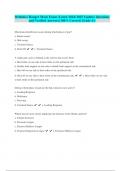
-
Orthotics Hanger Mock Exam (Latest 2024/ 2025 Update) Questions and Verified Answers| 100% Correct| Grade A+
- Exam (elaborations) • 34 pages • 2024
- Available in package deal
-
- $12.48
- + learn more
Orthotics Hanger Mock Exam (Latest 2024/ 2025 Update) Questions and Verified Answers| 100% Correct| Grade A+ Maximum dorsiflexion occurs during which phase of gait? a. Initial contact b. Mid-swing c. Terminal Stance d. Push Off c. Terminal Stance A single gait cycle is defined as the activity that occurs from: a. Heel strike on one side to heel strike on the ipsilateral side b. Double limb support on one side to double limb support on the contralateral side c. Heel off on one side to...
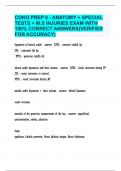
-
COKO PREP 6 - ANATOMY + SPECIAL TESTS + M.S INJURIES EXAM WITH 100% CORRECT ANSWERS
- Exam (elaborations) • 34 pages • 2024
- Available in package deal
-
- $14.99
- + learn more
ligaments of lateral ankle ATFL - anterior talofib lig CFL - calcaneal fib lig PTFL - posterior talofib lib lateral ankle ligaments and their actions ATFL - resist inversion during PF CFL - resist inversion at neutral PTFL - resist inversion during DF medial ankle ligaments + their actions deltoid ligament resist eversion muscles of the posterior compartment of the leg superficial: gastrocnemius, soleus, plantaris deep: popliteus, tibialis posterior, flexor h...

-
Prep U ACSM EP-C Exam Practice Questions with correct solutions.
- Exam (elaborations) • 28 pages • 2024
- Available in package deal
-
- $14.49
- + learn more
Longitudinal Muscle correct answers A muscle that produces low force and has a high contractile rate is classified as a _________ Dorsiflexion; talus correct answers The ankle's most stable position is in ______ due to the overall shape of the ______ Moderate Risk correct answers During the pre-participation screening your client is determined to have 4 risk factors. This is considered to be: Contraindication correct answers A reason or rationale NOT to perform exercise or testing R...
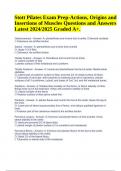
-
Stott Pilates Exam Prep-Actions, Origins and Insertions of Muscles Questions and Answers Latest 2024/2025 Graded A+.
- Exam (elaborations) • 16 pages • 2024
- Available in package deal
-
- $13.49
- + learn more
Stott Pilates Exam Prep-Actions, Origins and Insertions of Muscles Questions and Answers Latest 2024/2025 Graded A+. Gastrocnemius - Answer- A: plantarflexes and inverts foot at ankle, O:femoral condyles I: Calcaneus via achilles tendon Soleus - Answer- A: plantarflexes and inverts foot at ankle O: Upper 1/3 of fibia I: Calcaneus via achilles tendon Tibialis Anterior - Answer- A: Dorsiflexes and inverts foot at ankle O: Lateral condyle of tibia I: plantar surface of first metatarsal and c...
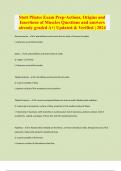
-
Stott Pilates Exam Prep-Actions, Origins and Insertions of Muscles Questions and answers already graded A+| Updated & Verified | 2024
- Exam (elaborations) • 25 pages • 2024
-
- $9.99
- + learn more
Gastrocnemius - A: plantarflexes and inverts foot at ankle, O:femoral condyles I: Calcaneus via achilles tendon Soleus - A: plantarflexes and inverts foot at ankle O: Upper 1/3 of fibia I: Calcaneus via achilles tendon Tibialis Anterior - A: Dorsiflexes and inverts foot at ankle O: Lateral condyle of tibia I: plantar surface of first metatarsal and cuneiform Tibialis Posterior - A: Inverts and plantarflexes the foot at ankle. Medial ankle stabilizer. O: Lateral part of posterior surface...

-
NBCE General Anatomy Exam || With Questions & Answers (Graded A+)
- Exam (elaborations) • 17 pages • 2024
-
Available in package deal
-
- $12.99
- + learn more
NBCE General Anatomy Exam || With Questions & Answers (Graded A+) NBCE General Anatomy Exam || With Questions & Answers (Graded A+) While examining a patient, you notice that the right scapula is farther from the midline than the left. You would suspect paralysis of which muscles? A. rhomboid major and minor B. latissimus dorsi C. supraspinatus D. deltoid - ANSWER - A. rhomboid major and minor Which of the following movements occur within the frontal plane? A. flexion of the leg B. ...
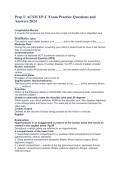
-
Prep U ACSM EP-C Exam Practice Questions and Answers 2024
- Exam (elaborations) • 25 pages • 2024
-
- $11.99
- + learn more
Prep U ACSM EP-C Exam Practice Questions and Answers 2024 Longitudinal Muscle A muscle that produces low force and has a high contractile rate is classified as a _________ Dorsiflexion; talus The ankle's most stable position is in ______ due to the overall shape of the ______ Moderate Risk During the pre-participation screening your client is determined to have 4 risk factors. This is considered to be: Contraindication A reason or rationale NOT to perform exercise or testing Rating...
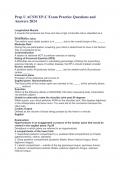
-
Prep U ACSM EP-C Exam Practice Questions and Answers 2024
- Exam (elaborations) • 25 pages • 2024
-
- $10.49
- + learn more
Prep U ACSM EP-C Exam Practice Questions and Answers 2024 Longitudinal Muscle A muscle that produces low force and has a high contractile rate is classified as a _________ Dorsiflexion; talus The ankle's most stable position is in ______ due to the overall shape of the ______ Moderate Risk During the pre-participation screening your client is determined to have 4 risk factors. This is considered to be: Contraindication A reason or rationale NOT to perform exercise or testing Rating...
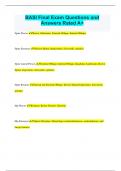
-
BASI Final Exam Questions and Answers Rated A+
- Exam (elaborations) • 19 pages • 2024
- Available in package deal
-
- $9.99
- + learn more
BASI Final Exam Questions and Answers Rated A+ Spine Flexors Rectus Abdominis, External Oblique, Internal Oblique Spine Extensors Erector Spinae (longissimus, iliocostalis, spinalis) Spine Lateral Flexors External Oblique, Internal Oblique, Quadratus Lumborum, Erector Spinae (logissimus, iliocostalis, spinalis) Spine Rotators Internal and External Oblique, Erector Spinae(longissimus, iliocostalis, spinalis) Hip Flexors Iliospoas, Rectus Femoris, Sartorius Hip Extensors Glu...
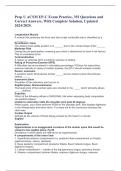
-
Prep U ACSM EP-C Exam Practice, 392 Questions and Correct Answers, With Complete Solution, Updated 2024/2025.
- Exam (elaborations) • 25 pages • 2024
-
- $12.49
- + learn more
Prep U ACSM EP-C Exam Practice, 392 Questions and Correct Answers, With Complete Solution, Updated 2024/2025. Longitudinal Muscle A muscle that produces low force and has a high contractile rate is classified as a _________ Dorsiflexion; talus The ankle's most stable position is in ______ due to the overall shape of the ______ Moderate Risk During the pre-participation screening your client is determined to have 4 risk factors. This is considered to be: Contraindication A reason or ...

Do you wonder why so many students wear nice clothes, have money to spare and enjoy tons of free time? Well, they sell on Stuvia! Imagine your study notes being downloaded a dozen times for $15 each. Every. Single. Day. Discover all about earning on Stuvia


